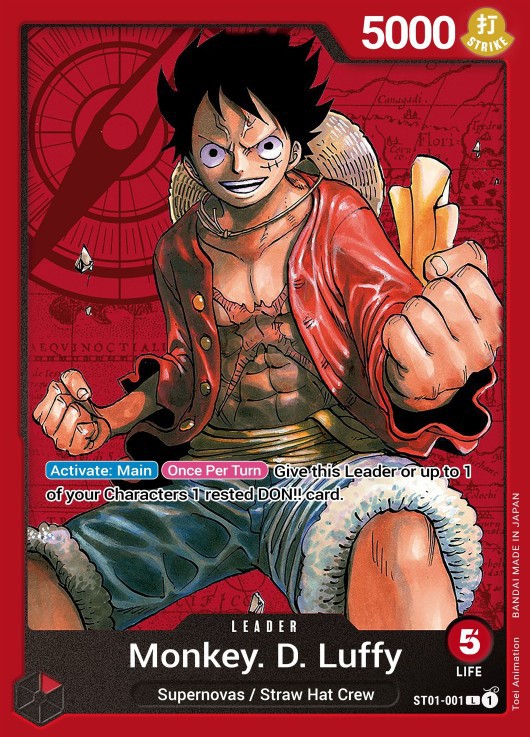How to Play the One Piece Card Game — Full Guide

As part of the 25th anniversary celebration for one of the best-selling manga in the entire world, Bandai-Namco introduced the One Piece Card Game in 2022 and has taken the world by storm since. With tournaments selling out in seconds and card product flying off the shelves, the hype around this card game is second to none.
Esports Illustrated’s One Piece Card Game expert takes players on an in-depth but brief intro into the One Piece Card Game in this how-to-play guide.
How to Build a Deck

Decks in the One Piece Card Game consist of 50 cards with no more or no less and also one card that starts outside of the main deck called a “Leader”. Leaders act very similarly to “Commanders” from Magic: The Gathering and decks will be built around the leader and their abilities. Another thing of note about One Piece Card Game decks is that decks are color restricted meaning that a deck can only consist of cards with the same color type as a player’s leader. For example, the Monkey D. Luffy leader from the starter deck is Red so any card going into a Monkey D. Luffy deck have to be only red.
In the 50-card main deck players may place any card into their deck as long as it matches the color requirement and can put up to four copies of any one specific card. A lot of cards in the One Piece Card Game will share the same name as another card, rest assured that the restriction isn't based, but instead card number. For example, a player may play four copies of Nami from the first booster set, Romance Dawn and four copies of Nami from the Straw Hat Pirates starter deck.

As for card types in the One Piece Card Game, there are three types that can be used in a deck. The most common will be characters. These cards will be how players combat the opposition. The next type of card is events which function like spells in other games. Essentially, these cards have a one-time use and then are placed in the Trash with some being used offensively and defensively. And finally, there are stages. These function like Field Spells in Yu-Gi-Oh! And enchantments in Magic: The Gathering. Essentially, these cards stay on the field and provide a continuous effect to the player or players.

Not included in the main deck is a separate 10-card “deck” which is known as the Don! Deck. These are simply resource markers that players will use to do different actions in the game. This 10-card deck is the same for every player in every deck but is vital to making the game playable.
Turn Order in Once Piece Card Game
Now that players understand how to build a deck, it's time to play the actual game. The object of the game is to reduce the enemy’s leader’s health to zero and then land a finishing blow. Once a player takes a direct hit while at zero life, they lose.
At the start of the game, players will decide who will go first or second and then draw five cards from the top of their deck. At this point, players may take a one-time mulligan in which they shuffle their hand into their deck and draw a new five-card hand. After both players complete this process, they will take the top cards of their deck up to the health of their leader and place them face down in the life area. Certain leaders have lower health than others with a majority having four or five life.

After this, the game begins. At the start of each turn, the turn player will take a card from their Don! Deck and place it into their Don! area. But after the first turn from the first player, at the start of every turn after, players will produce two cards from their Don! Deck every turn until they reach 10. These cards are how players will pay for the cost of abilities, to activate events or play characters from their hand onto the field. But Don! Has another critical use, players can alternatively attach Don! To their character or leader to boost their attack power for the turn which introduces a unique mechanic to the resource system in the game.
As for how combat works, players may attack with characters the turn after they are played (characters unless otherwise stated, can't attack the turn they are played) and with their leader on any turn past the first turn for each player. Characters and leaders have a power value in the top right of the card which will be used for their attack power and their defense power. In combat, players will compare the power of the characters in combat. If the attacking character has more power than the defending character, they are KO’d and put into the Trash. If a character or leader attacks the enemy leader and the power of the attacker is greater than the defending leader, the defending player will take a card from their life area and add it to their hand.
However, the defending player may counter out of attacks. Many characters will have a “counter” text box on the side of the card. When a player is under attack, they can discard any number of cards in their hand with counter to give the defending character or leader extra power to defend with. If a character or leader attacks a character or leader that has more power after the counter step, the attack fizzles and nothing happens. One key thing to note is that characters can only attack other characters that are “rested”. Attacking with a character or using certain abilities will rest a character leaving them open to being attacked.
The turn itself is fluid meaning that a player can attack with a character and then play another character and attack with their leader all in one continuous phase. Once a player has no more actions to perform, The turn ends and the next player starts their turn by drawing a card, restanding their rested characters and Don! Cards, gain an additional two Don! Cards from their Don! Deck and then proceed with their turn. This continues until one player wins.
